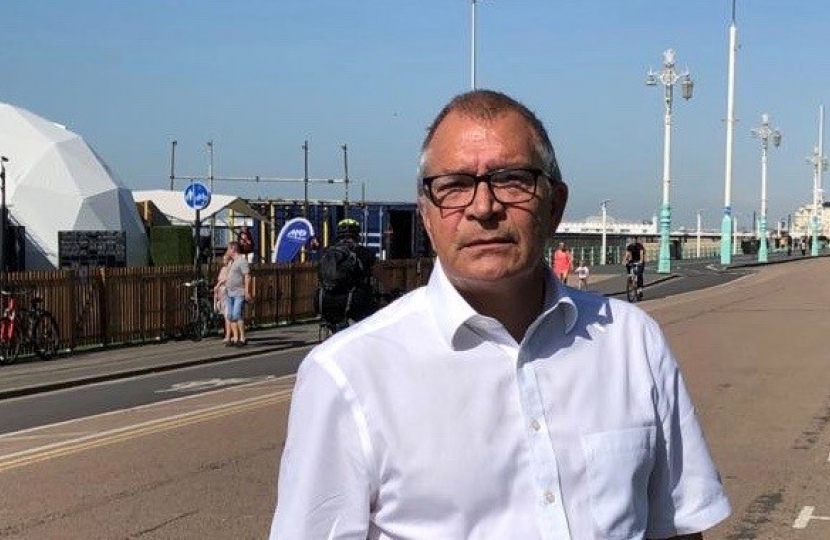
In July statistics were released showing that Brighton had recorded the third most polluted street in England out of 1300 sites tested.
The Brighton Clock Tower on North Street recorded a Nitrogen Dioxide recording of 90.8 ug/m –more than double the Government’s annual air quality objective of 40 ug/m3.
These statistics, collated from local authorities’ data, received surprisingly little comment or coverage from the council or the media at the time.
But given the current debates around transport in the City, this figure should be looked at carefully as it provides a key insight into how the City’s fragmented transport policy is going badly wrong.
A fragmented transport policy
A City’s Transport policy should be a holistic strategy to improve traffic flow and cut pollution and emissions
But our City’s current fragmented approach is creating pollution hotspots and congestion choke points.
In North Street the Council has long banned cars and made it bus and taxis only – presumably in an attempt to cut pollution.
But the result seems to be the opposite, with the constriction of the City’s road network capacity pushing traffic elsewhere – a constriction that has been made tighter still by the recent Valley Gardens road changes.
Over the last few months, we have seen plenty of other examples of this fragmented thinking.
The recently introduced Temporary Cycles Lanes on the Old Shoreham Road and A259 dramatically reduced road traffic capacity and caused traffic to grind to a halt.
By taking 2 lanes of the 4 lane Old Shoreham Road, capacity has reduced by 50% and an environmental hazard has been created.
Cars are backed up and stationary for miles at peak time particularly around the entrance to the Hove Recycling Centre where cars crawl along waiting for access. As the traffic inches along, fumes rise and chokes the surrounding areas.
Scientists have found up to 54 people living in the centre of Brighton die prematurely every year due to exposure to nitrogen dioxide (NO2), and with the COVID-19 pandemic being essentially a respiratory disease, this presents a real health risk to residents.
Cycling is supposed to help people live healthier lives and GPs across the country will soon be prescribing cycling to combat obesity. But the cycle lane at Old Shoreham Road cycle lane is having the opposite effect and putting people’s health at risk.
Similarly, the Temporary Cycle Lane on the A259 took a lane out of a key arterial road without proper consideration of the consequences.
This caused a traffic jam catastrophe when it was introduced earlier in the year with cars banked up for miles.
As the Argus reported, emergency vehicles were videoed battling to get through the traffic and the frustration of residents reached a peak and we heard examples of the traffic impacting people’s small businesses, disabled people and the City’s own bus service and taxi providers.
Pollution must surely have risen.
Between North Street, Old Shoreham Road and the A259 we have three examples of how the City’s fragmented Transport Policies is not working and likely causing more pollution.
But what is behind this continually fragmented approach?
Council Votes
The answer can be found in the votes at this week’s council meeting.
On Wednesday, for the second time in a matter of weeks, Labour and the Greens voted to keep the Temporary Old Shoreham Road Cycle Lanes in place at a key council meeting that went on for almost 7 hours.
Despite continued opinion articles and comments from Labour councillors expressing sympathy with residents suffering in the congestion, when it comes to the crunch, despite claiming they want Old Shoreham Cycle Lane removed, the Labour Group keeps voting to keep the temporary Cycle Lane in place.
But why? Why do they keep doing this, given all the evidence, all the petitions and the community sentiment against these temporary cycle lanes?
As Ollie Wilson, who campaigned to reopen Madeira Drive and attracted the support of 11,000 petitioners and disability advocates, said in his blog reflecting on his own interactions with Councillors in recent months:
“It quickly became apparent that the closure was not about Covid-19 at all, but was a symbolic gesture by the Hard Left to take out a road as a first step to making Brighton completely vehicle free”.
He went on to say “Broadly, I have always been a supporter of Green aims – but this Campaign made me realise just how out of touch and unecological the current generation of Green politicians has become”.
While the ideologically-driven left-wing councillors remain in charge of transport policy in this city, congestion and pollution will only get worse.
When the Conservatives were last in administration between 2007-11 we were approached with similar cycle lane plans for Old Shoreham Road and the A259.
We carefully considered the consequences, visited the sites, and rejected the proposals on the basis of the impact on traffic flow
The City needs to listen to the residents and Conservative voices to restore common sense and get the City’s transport flowing again.


